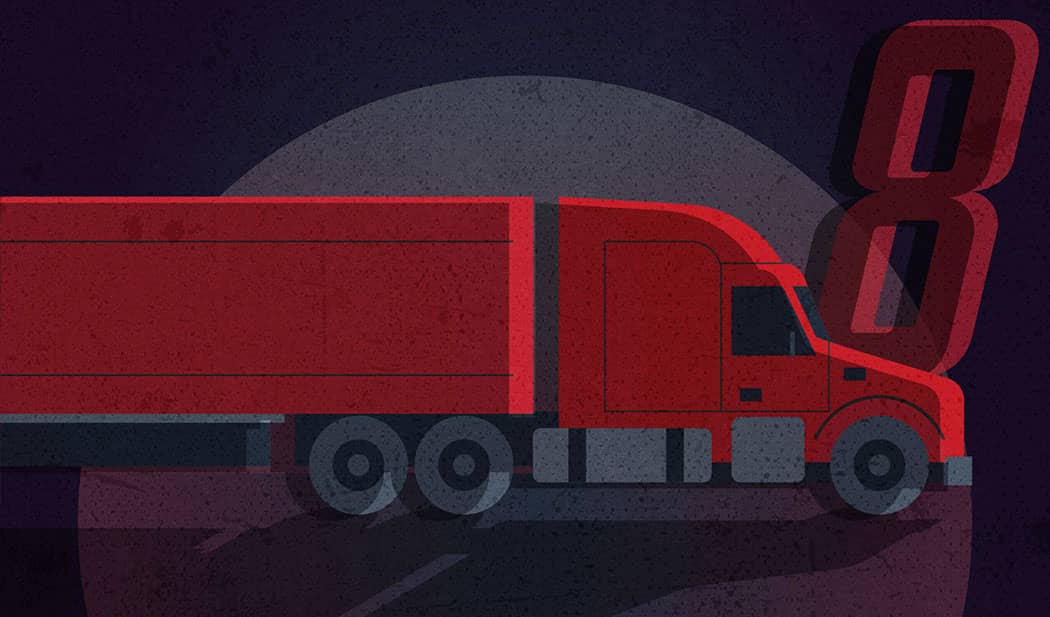What are Class 8 Trucks?

You know that iconic scene in Jurassic Park where the water cup ripples with each massive, menacing step of the approaching Tyrannosaurus Rex?
You know that feeling of waiting at an intersection to turn left and a massive 18-wheeler surges past, making your entire car shake?
Hear us out: Class 8 trucks are the T. rexes of the transportation world—massive, powerful, and impossible to ignore. They’re arguably even more terrifying than T. rexes, considering a T. rex can’t run at you going 60 miles per hour.
In our series about truck classifications, we’ve saved the biggest for last. Here’s what you need to know about Class 8 trucks (along with some fun dinosaur facts).
Definition of Class 8 Trucks
So, what sets Class 8 trucks apart from their less burly cousins? It’s all about the GVWR (Gross Vehicle Weight Rating)—the max weight of these bad boys when they’re loaded to the brim, including the truck itself, fuel, cargo, and the passengers.
The GVWR for class 8 trucks is 33,000 pounds and up. These heavyweights of the truck world aren’t just heavy-duty. They’re severe-duty.
(Fun fact: that’s about double the weight of a T. rex, which was estimated to weigh around 17,600 pounds. In other words, a T. rex would technically be considered a Class 5 truck.)
You can also recognize Class 8 trucks by their tandem rear axles. Balance is key, and unlike the short-arm-big-body situation going on with T. rexes, Class 8 trucks are built to safely distribute all the weight they’re responsible for.
There’s sort of a class beyond 8, too, for the especially large vehicles and loads that are considered “oversized.”
What are Some Examples of Class 8 Trucks?
Class 8 trucks are the really big boys, and just for commercial use at this point. Some of the most well-known Class 8 vehicles are:
Semi-Trailer Trucks
The classic 18-wheeler big rig is the most well-known example of a Class 8 Truck. These versatile icons of the trucking world can carry or tow a variety of cargo and serve nicely for long-haul transportation.
Cement Trucks
Smaller cement truck varieties can fit into Class 6 or 7, but the really massive ones that haul large quantities of cement are generally Class 8 trucks.
Dump Trucks
Just like cement trucks, dump trucks can fall into different classifications depending on the size and how much it’s capable of carrying. Class 8 dump trucks can handle 26,001 pounds or more, making them ideal for the mining industry or transporting a mama T. rex and her teenage rexling.
Regulatory and Licensing Requirements
Fun fact: T. rexes did not have any rules or regulations preventing them from stomping through the jungle and eating other dinosaurs. This made the dinosaur interstate a dangerous place, so our modern-age Department of Transportation (DOT) and Federal Highway Administration (FHWA) put stringent regulations in place to keep us all safe.
Here’s a sneak peek into some of these regulations:
Weight Limits
The Class 8 GVWR may appear open-ended, but there is a maximum. It’s set on a case-by-case basis using the complex Federal Bridge Gross Weight Formula. It’s a good Wikipedia page to read if you need help falling asleep.
Hours of Service
Equally important on the list is the allowed hours for driving trucks on the road. The HOS regulation ensures road safety by dictating how long commercial truck drivers can be behind the wheels per time.
Safety Standards
Functional safety features like brakes, mirrors, and lights are crucial for all trucks, including Class 8. Any commercial vehicle that weighs over 10,000 pounds must get a yearly DOT inspection for a comprehensive look at the truck’s health and safety.
Commercial Driver’s License (CDL)
It shouldn’t be a surprise to anyone, but truck drivers must have a commercial driver’s license with the appropriate endorsements. Obtaining this license requires passing a written and practical test. Other requirements for licensing may include medical tests, background checks, and driving history.
Operational and Maintenance Challenges
Fun fact: a T. rex’s life span was generally around 12 to 19 years, which sounds short compared to us humans, but is about on par with your typical 18-wheeler.
Of course, a truck’s years of service will vary depending on mileage and how well you stay on top of regular maintenance and repairs. Class 8 trucks bear a lot of weight, which puts a lot of stress on their tires, engines, and brakes. The extra weight also leads to additional challenges around fuel efficiency and secured, balanced cargo.
Complete a thorough inspection every time the truck visits the shop, and stay proactive when it comes to maintenance. Repairing and replacing parts before they become a problem saves cost and lives. Smart trailers are also becoming more common, leading to even more information and insights that keep the roads safe.
Don’t Wait for the Next Meteor to Hit
Fun fact: Tyrannosaurus rex is Latin for “King Tyrant Lizard.” Pretty badass. Didn’t save them from extinction, though.
Class 8 trucks are the kings of the road, but they need care and attention to stay safe and efficient. Fullbay makes that super easy for everyone involved—fleet managers, shop owners, truck drivers, service managers, technicians, accountants. From service order workflows and inventory management to customer communications and invoicing, we’re about 66 million years evolved from the T. rex.
See for yourself in a free guided expedition.

